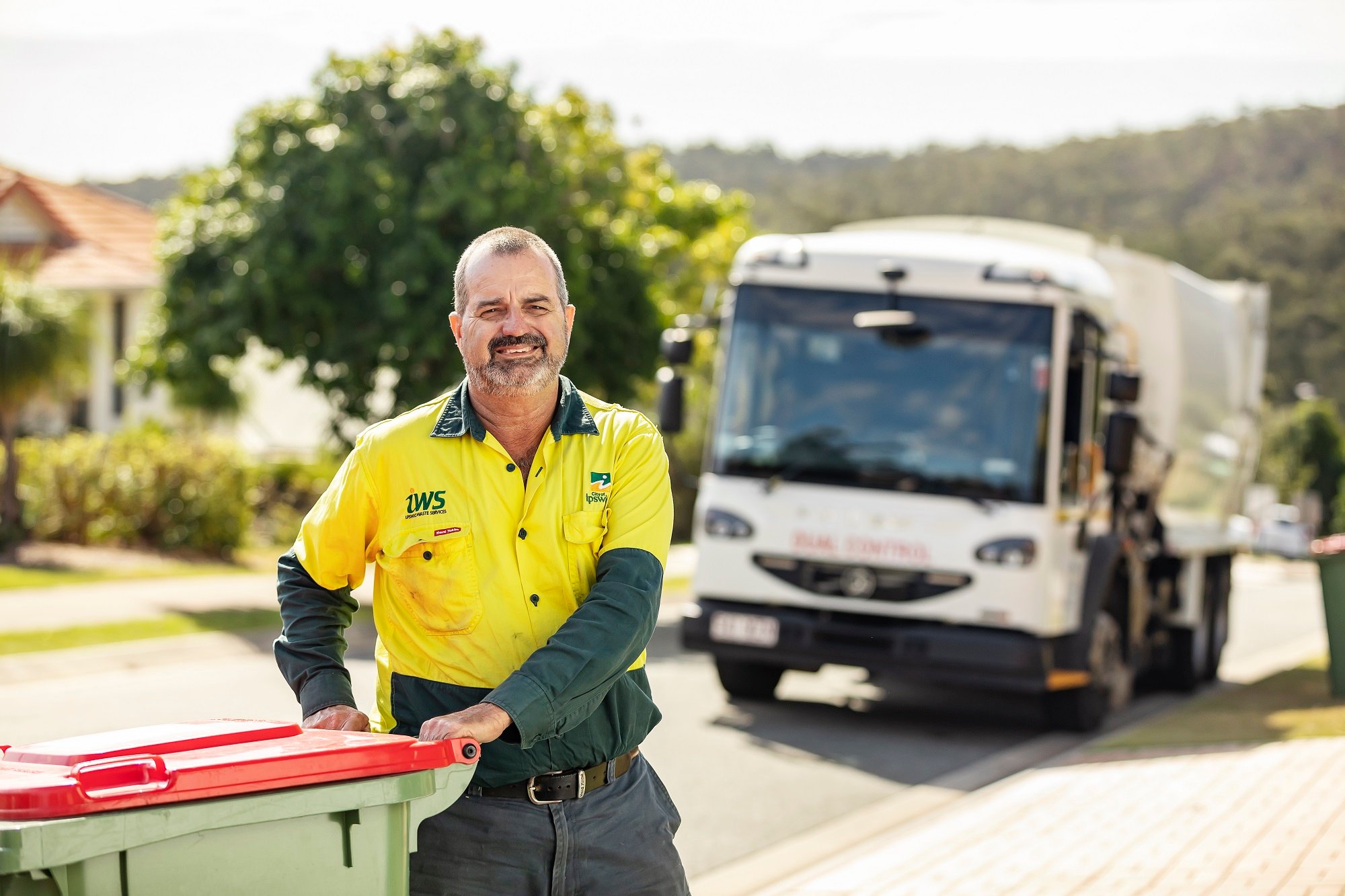3 min read
MAX-SAFE Rear Loader Pedestrian Protection increases safety for VRUs
Admin Updated on September 5, 2024

One of Australia’s recycling giants has become the first company in Australia to implement an innovative AI camera solution to protect unaware VRUs from a moving rear loader system.
Following a three-month trial in Brisbane in 2023, the MAX-SAFE Rear Loader Pedestrian Protection™ solution, developed by SGESCO-MAX, has been installed on 24 recycling trucks across Queensland, New South Wales and Victoria to remove a major Vulnerable Road User (VRU) safety risk.
The Safety Challenge
Large rectangular bins are commonly used by commercial or government businesses for garbage waste and for paper and cardboard recycling.
Speciallly designed collection and recycling trucks collect these bins by parking alongside them or reversing into tight spaces, laneway ends, carparks and roadsides. A driver rolls the recycling bin up to the back of the truck, sliding it over the two hyrdraulic arms of the rear loader that will flip the bin up over the top of the truck releasing the contents into the trailer before depositing the bin back down on the ground for the driver to wheel back to its original position.
To operate the rear loader, a driver stands to the rear side of a vehicle and presses a button to activate the lift mechanism. From their position, the driver has no visibility of what is happening on the other side of the vehicle. The rear loader can be operated from either side of the vehicle.
Pedestrians or cyclists moving down the side of a stationery truck can be unaware of the operations at the rear of the vehicle and the risks assocated with stepping behind the vehicle and connecting with a large and heavy moving arm and bin.
With the prevelance of mobile technology, people often walk around with their eyes on their phone or talking to someone on the phone, making them less aware of their surroundings and noises. It’s a hazardous situation for vulnerable road users (VRUs) because the dangers are not obvious when the vehicle is stationary.
The Solution
The MAX-SAFE Rear-Loader Pedestrian Protection System is a new, advanced, AI-camera-based solution designed to protect pedestrians in the vicinity of a rear loader waste vehicle when it is lifting and lowering bins.
The solution identifies any VRU that approaches the rear loader from the side opposite to where the operator is standing.
The cameras are mounted in the optimal position, typically up high on each side towards the rear of the vehicle. Using the latest advances in Artificial Intelligence (AI) and Machine Learning (ML) the solutions detect humans within a 3m x 6 m defined zone next to the vehicle alerting the vehicle operator.
Any pedestrian detected within that zone during lifting operations will trigger the system, alerting the operator via an audible alarm and flashing LED lights, prompting the operator to hit the emergency stop.
The rear loader safety solution works with both control panels at the back of the vehicle to monitor the opposite side of the vehicle to the one the driver is operating, ie. if the operator is controlling from the left side, the right side is monitored and protected, and vice versa.
When the rear loader mechanism is not in operation, the system is disabled, hence there are no alerts while the vehicle is stationary or moving.
The solution protects not just VRUs but also drivers, vehicles and property as well.
The Trial & Roll-out
During the trial of the MAX-SAFE Rear-Loader, the solution was fine-tuned to ensure the volume was set to a level that could still be heard over the noise of the truck to alert the operator but not travel far and disturb other people at night.
The trial proved the accuracy of the system to detect VRUs, with only 1 false alert when the camera identified a face on the advertising decal of a nearby parked minivan.
One of the benefits of the MAX-SAFE Rear-Loader Pedestrian Protection solution is that it is installed on the body of a rear loader and operates completely independently to the engine of the heavy vehicle.
It is suitable for any make or model of waste truck with SGESCO-MAX able to work with body builders, like Bucher or Superior Pak to advise on installation.
This makes for a streamlined roll-out by SGESCO-MAX and its dealer network.
Safety Priority
“Waste Management companies are often our pioneer partners when it comes to heavy vehicle safety solutions,” said Scott McPherson, Managing Director of SGESCO-MAX.
“Garbage and recycling trucks are common-place heavy vehicles on our city and surburban streets, coming into unavoidable close contact with VRUs day and night. Like the civil construction industry, the waste management sector has vehicles that are unique to the work they do. Rear and front loaders are two such vehicles.”
“Our MAX-SAFE Rear-Loader Pedestrian Protection uses the best of global technologies in an advanced, reliable and affordable solution to improve safety around rear loader vehicles, reduce hazards for pedestrians and the potential devastating consequences for the operators of such vehicles.”
“The investment in such technology is worth it to remove this safety risk of rear loaders. Any accident with a rear loader will likely result in vehicle downtime, investigations, insurance claims and possible disciplinary action, as well as trauma and recovery rammifications for the operator and injured party.”
“By saving just one accident on a truck our solution will more or less pay for itself, while giving years of protection,” said Scott.
Key Benefits
The MAX-SAFE Rear-Loader Pedestrian Protection solution
- PROVIDES ASSISTANCE to the driver/operator.
- SAFEGUARDS BLINDSPOTS around the rear and rear sides.
- PROTECTS PEDESTRIANS, cyclists and motorcyclists.
- HIGH ACCURACY – detects people (stationary and moving).
- AFFORDABLE solution.
- Provides ALERTS and AUDIBLE WARNINGS.
- STATE-OF-THE-ART AI TECHNOLOGY.
- Options for more ACTIVE SAFETY MEASURES.
- GREATER SAFETY and PEACE OF MIND – for drivers and fleet managers.
- Part of the MAX-SAFE SAFETY ECO-SYSTEM.
Discover more related news

SGESCO-MAX joins NRSPP
FIRST VEHICLE SAFETY TECH DEVELOPER TO JOIN 15 May 2021 SGESCO-MAX is excited to become the first vehicle safety technology partner of theNRSPP...

Keeping Australia’s Mining Workforce Safe: The Critical Role of Bus Safety in Remote Transfers
Australia’s resource sector, which employs around 320,000 people, accounts for over 60% of our export revenue. As a key pillar of Australia’s...
